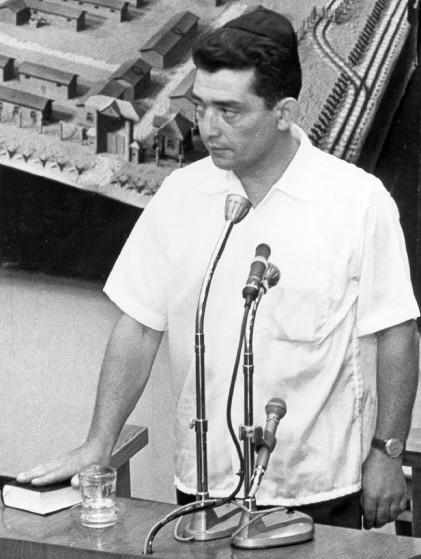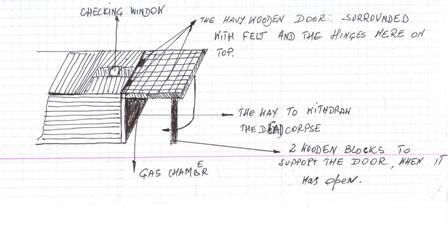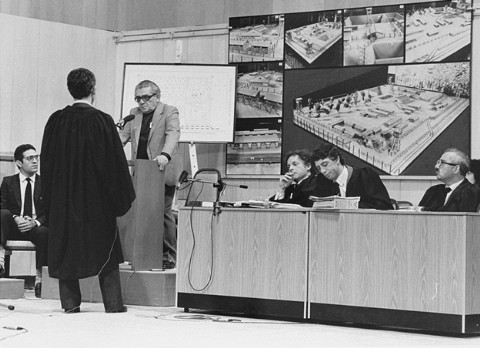Holocaust Education & Archive Research Team |
|
Trials Introduction to the Holocaust Trials
Trials
Interrogations & Testimonies
The IMT Series Nazi Justice
| |||
Eliahu Rosenberg Testimony about Treblinka at the Eichmann Trial 1961 (Selected Extracts)
Eliahu Rosenberg was deported from Warsaw to Treblinka along with his mother and three sisters in September 1942. He escaped during the revolt on the 2 August 1943.
At the Eichmann trial in Jerusalem in 1961, Eliahu Rosenberg described their arrival, a member of the Blau Kommando said:
“He did not say it to me, but to his friend, an acquaintance of his, in Yiddish, “Moshe, chap a besem un rateve sich!” (Moshe, grab a broom and save yourself)
“This man took hold of a broom that was lying at the side, went into the freight cars and began sweeping the cars. Kurt Franz – he passed by with a peitsche (whip) in his hand, and took men from the ranks who were sitting on the floor several men, about thirty of them. When I saw this I jumped into this group, with a parcel in my hand, and I stood there together with them.
Eliahu Rosenberg arrived in Treblinka with his mother and three sisters:
“When we alighted from the freight cars amidst the shouting, they transferred my mother and my sisters to the left-hand side. I managed to exchange one word with my mother:
“If you reach any place write a letter to a Pole named Kowalski in Warsaw and I shall also send a letter to you, and in this way we shall know where we are.”
Eliahu Rosenberg told the court of their fate:
“They were buried in Treblinka, I got to know they were in a particular grave.” -He continued about his arrival.
“When Kurt Franz chose the working party of thirty men, when he finished this selection, he began to shout and ask, “who came in here without permission?” Naturally, none of these men knew who the extra one was - I was then saved from certain death.
He made a sign to the Ukrainian standing by his side, I don’t know what it was, but they began chasing us towards the first camp. Inside the first camp, they told us to throw down the parcels we had with us, and we began sorting the parcels, an enormous heap of parcels – shoes separately, clothing separately, children’s wear separately, gold separately and all kinds of articles separately.
And I worked in this way the whole day, the next day we went out in the morning- it was 11’o’clock – to a roll call. After this roll call, they directed us to a heap, to do roughly the same thing – to sort out all these goods.
After a short while, SS-Scharfuhrer Matthias (Matthes) appeared and shouted “Twenty men volunteers.” I was standing near him. I was afraid that as I was standing near him and if I did not step forward, he would take revenge on me or strike me. I stepped forward.
He said, “You are going out to light work for ten minutes.” They took us to Camp 1 (should be Camp 2) – the death camp. The gate was camouflaged with pine branches, when they opened the gate, we went in.
All of us were automatically in a state of shock, for we saw a pile of corpses. And the German Matthias (Matthes) began shouting to the group, “An die Tragen” (to the stretchers).
We did not understand what was going on. We began running around the bodies. The Germans and Ukrainians who were present there hit us. We did not know what we were supposed to do.
The Jews who worked on removing the bodies said to us, “Take hold of the stretchers and put a body on each.” We seized a stretcher, another person and I, I don’t know what his name was, we went up to the pile, and we took a body away on a stretcher.
We walked to the graves – 150 metres to 200 metres to the grave, and we threw the bodies down below. The grave was six to seven metres deep, it was built with a slope, in a conical shape.
When we left for work in the morning, SS men divided us into working groups – there were three kinds of labour there, there were the gas chambers, the transfer of the bodies to the graves, and after that, there was the burning of the bodies.
Eliahu Rosenberg described the extermination process:
“The people arrived from this famous “Himmelstrasse,“ the entire staff of Camp 2, stood there with dogs, with whips and bayonets. The people walked past in silence. That was in the beginning, in summer 1942. They did not know where they were going.
When they entered the gas chambers, two Ukrainians stood next to the entrance – one was Ivan and the other was Nikolai. They introduced the gas. The gas came from an engine -it was Ropa – Ropa gas. It was gas from an engine. They put in Ropa, which was a kind of oil, a crude oil and the fumes entered the gas chamber.
The people who were the last to enter the gas chambers, the very last received stabs in the bodies from the bayonets, since the last persons already saw what was going on inside and did not want to enter.
Four hundred people were put into one small chamber, and when they forced them in, they, on their part, pressed inwards and in this way reached the full capacity, so that only with difficulty could the outer door of the chamber be shut.
When they shut them in, we were standing on the outside, we only heard cries of “Shema Yisrael, Father, Mother.” Thirty five minutes later they were dead.
Two Germans stood there listening to what was going on inside, afterwards they said “Alles Schlafen.” They ordered us to open the door, we opened the door and removed the bodies.
In Camp 2, there were roughly two hundred men working on removing the bodies from the gas chambers. Eliahu Rosenberg was asked once more about the gas chambers
“I have already said that this building had three chambers. Here, there were five on this side and five on that side. Once – and I remember this well – all the gas chambers were operating.
Ten thousand people entered all at once, within forty –five minutes. This was a transport of thirteen thousand persons who had arrived on that day.
Each chamber was sealed – absolutely hermetically sealed. There was a kind of folding door that opened downwards, we extracted the “clins.” The “clins” were pieces of wood that used to hold the doors in place.
When the door was folded and fell to the bottom, there were actually two boards there. One was on top of the door and the other at the bottom, and again, with these pieces of wood, these “clins” we closed it hermetically and stood to the side. We closed it from the outside, before that the Germans stood on the ramp and watched what was going on inside. When they said “Alles Schlafen” ( All Sleeping) we opened it up and stood aside for three minutes until the fumes had dispersed, and then we removed them. We then threw them down the ramp.
When I removed the bodies from the gas chambers, the people, mostly women, had hidden all kinds of documents and money in their private parts, and they fell out afterwards, and we saw them.
There were many cases of people from the gas chambers who remained alive, those who survived were mainly children who slipped to the floor, and when we opened the gas chamber and removed the bodies, we saw children underneath who had remained alive. The Germans took them away and shot them.
Sources:
The Complete Transcripts of the Eichmann trial – Nizkor US National Archives Ghetto Fighters House Holocaust Historical Society
Copyright. Johannes Weber H.E.A.R.T 2008
|




